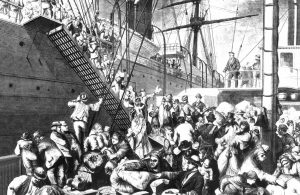Along with the Civil Rights campaigns of the 1960s, this was one of the most divisive forces in twentieth-century U.S. history. The antiwar movement actually consisted of a number of independent interests, often only vaguely allied and contesting each other on many issues, united only in opposition to the Vietnam War.

Attracting members from college campuses, middle-class suburbs, labor unions, and government institutions, the movement gained national prominence in 1965, peaked in 1968, and remained powerful throughout the duration of the conflict. Encompassing political, racial, and cultural spheres, the antiwar movement exposed a deep schism within 1960s American society.
The 1960s was a time of dramatic social engagement and action. In addition to the civil rights and antiwar movements, a powerful women’s rights movement also took root. The Cold War continued throughout the decade and nearly erupted in nuclear war during the Cuban Missile Crisis in 1962. Cold War anxieties and concerns over Soviet domination in Asia led to the build-up of American forces in Vietnam and the Vietnam War.
As Americans approached the 1960 presidential election, life was good. Americans reveled in their music and the stardom of movie icons such as Marilyn Monroe and Marlon Brando, and they enjoyed the new medium of television.
Lyndon Baines Johnson (1908-1973) was President of the United States from 1963 to 1969. In Texas, Johnson was the state director of the National Youth Administration, a New Deal agency. He came to Washington D. C. as a devoted New Deal Democrat in 1937 when he was elected to the House of Representatives.
Johnson became a United States Senator in 1949 and the Senate majority leader in 1955. Originally a rival of John F. Kennedy for the Democratic presidential nomination, Johnson ran and then served as Kennedy’s vice president. In 1969, Richard M. Nixon is inaugurated 37th president of the U.S. (Jan. 20). Stonewall riot in New York City marks beginning of gay rights movement (June 28).
The first U.S. manned sub-orbital space flight is completed with Commander Alan B. Shepard Jr. inside a Mercury capsule launched 116.5 miles above the earth from Cape Canaveral, Florida in 1961. Twenty days later, President Kennedy announces his intention to place a man on the moon by the end of the decade.
In 1969, the Apollo program completes its mission. Neil Armstrong, United States astronaut, becomes the first man to set foot on the moon four days after launch from Cape Canaveral. His Apollo 11 colleague, Edwin E. Aldrin Jr. accompanies him.
1960s timeline, 1960 facts, 1960s culture, 1960s politics, 1960s pop culture, 3 major world events in the 1960s, what happened in 1960, 1960s civil rights movement
